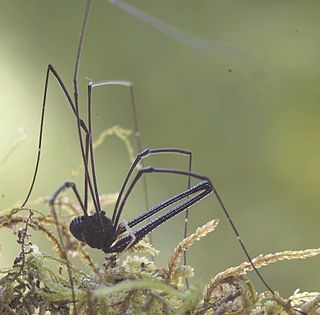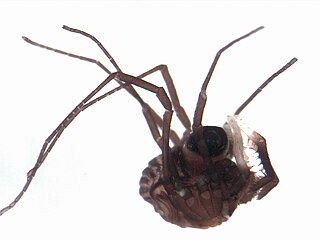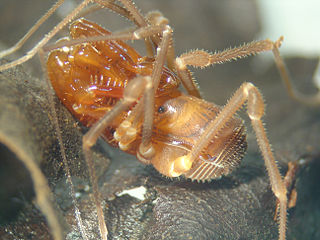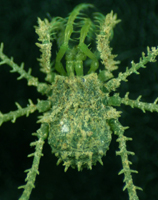
The Opiliones are an order of arachnids colloquially known as harvestmen, harvesters, harvest spiders, or daddy longlegs. As of April 2017, over 6,650 species of harvestmen have been discovered worldwide, although the total number of extant species may exceed 10,000. The order Opiliones includes five suborders: Cyphophthalmi, Eupnoi, Dyspnoi, Laniatores, and Tetrophthalmi, which were named in 2014.

Cosmetidae is a family of harvestmen in the suborder Laniatores. With over 700 species, it is one of the largest families in Opiliones. They are endemic of the New World with a Nearctic-Neotropical distribution where a large fraction of the diversity of Opiliones are represented by this single family. Cosmetidae have the northern extent of their range into the USA, where a small number species occur in the southern states. However, the family is especially diverse in Mexico, Central America and northern South America; especially the Andean realms. Their range also extends further south into Argentina and southern Brazil, but they are absent in Chile. Cosmetidae are prevalent in Amazonian region, but only relatively few also occur in Brazilian Atlantic Forest. Several species are also found in the Caribbean.

The Eupnoi are a suborder of harvestmen, with more than 200 genera, and about 1,700 described species.

Cyphophthalmi is a suborder of harvestmen, colloquially known as mite harvestmen. Cyphophthalmi comprises 36 genera, and more than two hundred described species. The six families are currently grouped into three infraorders: the Boreophthalmi, Scopulophthalmi, and Sternophthalmi.

The Neopilionidae are a family of harvestmen.

Caddoidea superfamily of harvestmen arachnids with a single family Caddidae, which now only contains 2 extant species. The family previously contained many more taxa under a previous wider concept, but the familial definition was narrowed after restudy.

The Ceratolasmatidae are a family of harvestmen with eleven described species.

Epedanidae is a family of the harvestman infraorder Grassatores with about 200 described species. They are the sister group of the Gonyleptoidea.
The Stygnopsidae are a small family of harvestmen, with almost all species found in Mexico.
The Stygnidae are a family of neotropical harvestmen within the suborder Laniatores.
Agoristenidae are a neotropical harvestman family of the Suborder Laniatores, in the superfamily Gonyleptoidea.

The Cranaidae are a family of neotropical harvestmen within the suborder Laniatores.
The Zalmoxidae are a family of harvestmen within the suborder Laniatores.
Escadabiidae is a small neotropical family of the harvestman infraorder Grassatores with six described species.

Stygnommatidae is a small neotropical family of the harvestman infraorder Grassatores with about thirty described species.
Biantidae is a family of the harvestman infraorder Grassatores with about 130 described species.

Podoctidae is a family of the harvestman infraorder Grassatores with about 130 described species.
The Fissiphalliidae are a small neotropical family of harvestmen within the suborder Laniatores.
The Synthetonychiidae are a small family of harvestman with a handful of species in a single genus. They are endemic to New Zealand.

The Travuniidae are a small family of harvestman with little more than ten described species, within the suborder Laniatores.











